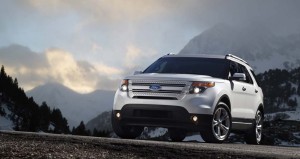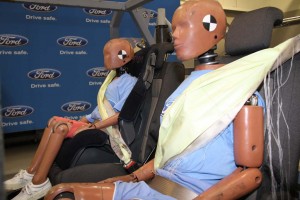When Ford Motor Co. launches its complete redesign of the Explorer sport-utility vehicle for 2011, the maker will be aiming to rebuild a once-dominant franchise that has become little more than an also-ran in the huge multi-purpose vehicle market.
The new model shifts gears in a number of ways. A critical part of the redesign was moving from a truck-based body-on-frame platform to a car-like chassis borrowed – and then heavily modified – from the Taurus sedan. Ford will emphasize the best-of-all-worlds capabilities of the 2011 Explorer.
But it will put a particular premium on pitching the new crossover/SUV’s safety technology –notably including some key features making their worldwide debut on the 2011 Explorer. That strategy, the company hopes, will help overcome a lingering bad taste in the market that was caused by the Firestone tire fiasco, nearly a decade ago, when wags dubbed the long-popular vehicle, the “Ford Exploder.”
The 2011 Ford Explorer offers a wide array of the latest technology, from electronic stability control to cross-traffic alert, a radar-based system that can spot oncoming traffic when a motorist is backing out of a parking spot. That technology underscores several trends in the overall car market, and at Ford in particular.
Cross-traffic alert first debuted on the re-make of the BMW 7-Series, two years ago, but was quickly added to the Ford Taurus. Traditionally, technology advances were launched on high-line models, like BMW’s, and then it would take years to slowly migrate down to the mainstream market. Ford has not only been pushing to shorten that cycle but to actually take the lead with technology that luxury makers will need to catch up on.
The Explorer, for one thing, will make its debut with a system called Curve Control. Using the same basic sensors and onboard computers as stability control, the system is designed to sense when the vehicle is entering a corner too quickly. It will then use a combination of automatic braking and throttle controls to scrub as much as 10 mph per second off the vehicle’s speed, increasing the likelihood the driver will navigate through the corner safely.
The Explorer also will debut a new airbag system that will be sewn into the shoulder belts used in the Explorer’s second row of seats. The $395 option is designed, according to Ford safety chief Sue Cischke, to reduce injuries and deaths among children and the elderly, those who are particularly vulnerable to crash impact forces.
The technology has been available for a number of years but, until recently, was limited to the aviation industry, where it was first offered on business and private aircraft and has just begun to be introduced on commercial fleets, such as some of the 777 jets flown by Delta Airlines.
The belt-minded airbags operate a bit differently from conventional bags in that they rely on cold, compressed gas stored in tanks under the seats. Conventional airbags are triggered by the ignition of an explosive “squib” that creates a rush of hot gases. In close proximity to the body, that approach would risk burns and other injuries.
Ford has made significant improvements in the quality of its vehicles, notes Amy Marentic, the marketing executive overseeing the launch of the 2011 Ford Explorer. The challenge is to go beyond the traditional “things-gone-wrong” measurements and put a focus on what the industry calls, “things-gone-right.”
But while Explorer will get some significant new features in its bid to regain its once-lofty position in the multi-purpose vehicle market, Ford officials promise to spread the new emphasis across their entire line-up, starting with Curve Control and the airbag seatbelts which, safety czar Cischke says, could become available across the Ford line-up in the next few years.
Of course, Ford isn’t alone. General Motors is betting a big push on safety can help give momentum to its own revival efforts. The maker is building in 10 airbags on its new Chevrolet Cruze sedan, for example.
The interest in safety as a marketing tool is particularly significant right now considering Toyota’s ongoing recall issues which, analysts say, give its competitors the opportunity to shine their own brand image even as Toyota struggles with the tarnish on its own halo.
(Toyota announces the recall of another 1.53 million vehicles. Click Here for more.)


